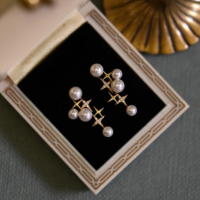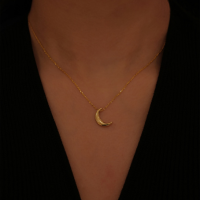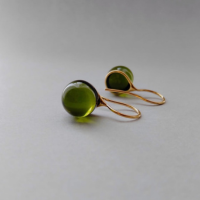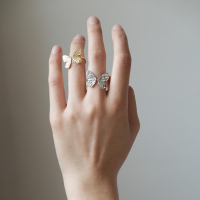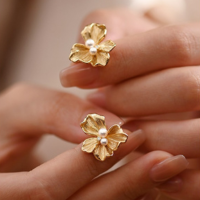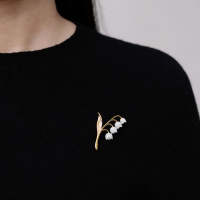
How to Care for and Clean Your Brooch Collection
Check out our personalized jewelry collections! (kids drawing jewelry, coin jewelry, wire jewelry, fingerprint jewelry, handwriting jewelry, and more)
Brooches have a special place in our accessory collection, elevating outfits and showcasing personal style. They can be cherished family heirlooms or those cute pins collected over time. To keep these treasures looking their best, it's crucial to clean and care for them properly. Knowing how to treat different materials ensures that brooches remain stunning and beautiful.
We might worry about damaging our favorite pieces, but don't fret; daily care isn't as tough as it seems. Some gentle cleaning methods and smart storage ideas can work wonders for preserving brooches. Maintenance can keep them glistening whether made of classic metals or crafted with sparkling gems.
If we've ever wondered about preserving our collection professionally, there are reliable options available. Regular check-ups and professional cleaning can extend the life of brooches. Let's together explore which strategies will keep our brooch collection in top shape.
Key Takeaways
- Proper cleaning keeps brooches stunning.
- Daily maintenance is easier than it seems.
- Professional care extends the life of your collection.
Understanding Brooch Materials
In our brooch collections, we find a variety of materials, each offering a unique appeal and requiring specific care. Knowing the materials is essential to keep our pieces in pristine condition.
Precious Metals
Precious metals like gold, silver, and platinum are commonly used in brooches. Gold can come in different karats and colors, such as yellow, white, and rose. It's important to keep it away from harsh chemicals. Silver tends to tarnish, so polishing regularly helps retain its shine. Platinum is durable but can scratch over time. To maintain these metals, it's best to store them in soft pouches and clean them with non-abrasive cloths.
Gemstones and Crystals
Our brooches often feature beautiful gemstones like diamonds, rubies, or sapphires. Crystals like Swarovski are also popular. Gemstones usually require gentle cleaning with a soft cloth and mild soap solution. Avoid exposing them to extreme temperatures or direct sunlight, which can dull their brilliance. Crystals, being softer, need extra care. We should avoid dropping or knocking these pieces to prevent chipping or cracking.
Enamel and Glass
Enamel provides vibrant color to brooches but requires careful handling. It can chip easily, so we should avoid rough handling. Dust and clean enamel with a microfiber cloth or warm water and mild soap. Glass elements, often delicate, also need gentle cleaning. Avoid immersing them in water as it might weaken the settings. Instead, clean with a damp cloth to keep them sparkling.
Organic Materials
Brooches sometimes include organic materials like wood, bone, or pearl. Wood and bone should be kept dry and away from direct sunlight to prevent cracking. Dust lightly and moisturize with specialty oils when necessary. Pearls are sensitive to chemicals and need to be wiped with a soft cloth after wearing. Store these materials separately to avoid scratching them against harder surfaces.
Daily Care of Your Brooches
Taking good care of our brooches daily keeps them shining and prevents wear. By storing them properly and protecting them from damage, we can enjoy our collection for years.
Proper Storage Solutions
Storing our brooches carefully is key. Use small jewelry boxes or pouches with soft linings to keep them from scratching each other. Velvet-lined trays are great for organizing them and make them easy to see.
Place brooches in a drawer or on a shelf away from direct sunlight, which can fade colors. Humidity can damage some materials, so choosing a dry, cool place is crucial. Our goal is to keep them safe from dust and damage.
Preventative Measures Against Damage
We need to handle our brooches gently. Always check the clasps before wearing them to ensure they are secure. If a clasp is loose, we can easily repair it with a small tool or take it to a jeweler.
Avoid wearing brooches when doing activities that might cause them to snag or hit hard surfaces. Cleaning them with a soft, lint-free cloth removes fingerprints and smudges without scratching the metal or gemstones.
Using jewelry cleaner specific to the materials of our brooches keeps them looking new. Be sure to follow the cleaner's instructions to prevent any harm to the brooches' surfaces. These steps help us maintain a beautiful collection.
Cleaning Techniques for Brooches
When caring for brooches, different materials need special attention. Let's focus on polishing metals, caring for gemstones, and handling enamel surfaces. It's important to use the right techniques and products to keep our brooches looking their best.
Polishing Metals
For metal brooches, we must use gentle polishing cloths. These cloths remove tarnish without scratching. A microfiber cloth is often the best choice.
Silver brooches benefit from special silver polish. We dab a bit on the cloth and rub gently. This helps in bringing back the shine.
Logically, it’s important to avoid harsh chemicals on gold and silver. They can cause damage. We stick to specific metal cleaners, especially those meant for jewelry.
If the brooch has intricate designs, a soft brush helps us reach the grooves. We use it carefully to avoid bending any delicate parts. Regular cleaning every few months maintains the metal’s luster and prevents oxidation.
Caring for Gemstones
Gemstone brooches require attention. If we have diamond or sapphire brooches, soapy water and a soft brush usually do the trick. A few drops of mild soap in warm water can make a big difference.
Some stones like opals or pearls are more sensitive. For these, plain water is safer. We also dry them completely with a cotton cloth.
We never soak gemstone jewelry. It can loosen the setting. Instead, we gently dip the parts that need cleaning. A soft, lint-free cloth eliminates leftover moisture, helping to keep the stones dazzling without any risk of damage.
Handling Enamel and Delicate Surfaces
Dealing with enamel surfaces needs care. Use a soft, damp cloth to wipe away dust. Never scrub. Scrubbing enamel can lead to scratches or chipping.
Warm water is safe, but avoid soaking. Too much exposure to water can loosen the enamel. It’s better to wipe gently and dry the piece quickly.
Delicate surfaces need particular care. If in doubt, air drying on a clean, soft surface is a safe option. Clean, dry cloths are handy for dealing with any remaining moisture or residue. This approach helps preserve the delicate beauty of enamel and other sensitive areas.
Professional Care and Maintenance
Sometimes, taking proper care of our brooch collection requires professional help. Knowing when to seek out a jeweler and choosing the right one ensures our brooches stay in top condition. Let's explore these aspects further.
When to Seek a Professional
We may find that our brooches need expert care if they show signs of damage or wear. Missing stones, loose clasps, or tarnished metals often require professional attention.
Occasionally, deep cleaning can also be necessary for older pieces or those with intricate designs. If we notice any issues, it's crucial to address them quickly. Delays might lead to further damage, making repairs more costly in the long run. It's wise to have our brooches checked annually by a professional. They can spot and fix minor problems before they become bigger issues.
Choosing the Right Jeweler
Selecting the right jeweler ensures our brooches receive the best care. We should look for professionals with experience in handling jewelry similar to ours. Services offered vary, so it's helpful to find out what specific repairs or maintenance they provide.
Reviews and recommendations from other jewelry enthusiasts can guide us in selecting a reputable jeweler. Another consideration is the jeweler’s certification or membership in professional organizations, as it reflects their expertise. Visiting a few jewelers and asking questions about their processes can also provide insight into their skill and suitability for our collection.
Repairing a Damaged Brooch
Brooches can sometimes get damaged, perhaps through wear or an accidental drop. We must first identify the damage and then decide between attempting a DIY repair or seeking professional help.
Identifying Common Damages
Brooches can suffer from various types of damage. Loose clasps are common and often prevent secure attachment. This can risk losing the brooch altogether. Missing stones are another issue, making the brooch look incomplete. Bent pins can make it difficult to fasten the brooch properly.
Other damages might include scratches or tarnishing, especially with metal brooches. Loose settings for gemstones can make them prone to falling out. Paying close attention to the brooch details helps in deciding the next steps for repair. Evaluating these issues is key before we choose a repair path.
DIY Repairs vs. Professional Restorations
Sometimes, we can manage simple repairs at home. For instance, tightening a loose clasp might only need some small pliers. Replacing a missing stone can often be done with a bit of glue and a replacement stone. Small scratches might be polished out with a gentle cloth and some polishing compound.
For more complicated problems, it's often best to consult a professional jeweler. If we're dealing with valuable or antique brooches, professional restoration ensures preservation and safety. They have the tools and expertise required to handle intricate settings and metals. Knowing when to seek help ensures our brooches remain beautiful and functional for years to come.
Displaying Your Brooch Collection
Displaying brooches can be a fun way to showcase their beauty. Let's explore creative ideas to present them and how to keep them pristine while on display.
Creative Presentation Ideas
We can get creative with brooch displays. Shadow boxes are perfect for highlighting their details. Choose a shadow box with a felt or velvet back. Pin each brooch inside, making sure they don’t touch. This prevents scratches.
Another idea is using decorative trays. Brooches can be laid out on pretty plates or trays covered with soft fabric. Choose materials that won’t tarnish the metal. Arrange by color or theme to make them pop.
Corkboards work well, too. Cover a corkboard with fabric, then pin brooches in different patterns. It allows for easy rearrangement. Using a picture frame without glass is another option. Attach brooches to fabric and hang them like art.
Maintaining Brooches on Display
While displayed, brooches can gather dust or dull over time. It’s important to keep them clean. We recommend using a soft brush to remove dust gently every few weeks. This prevents build-up and keeps them shiny.
Direct sunlight can fade colors. Place displays away from windows or use UV-filtering glass. This helps protect their vibrant colors.
Humidity is another factor to manage. Metal can tarnish if moisture is present. Use silica gel packets in display cases to absorb excess moisture. Regularly check brooches for any signs of rust or tarnishing and treat them immediately.
Remember, a little care ensures our brooches shine and stay beautiful while on display.
Insuring Your Brooch Collection
Protecting our brooch collection with insurance is an important step. This involves assessing its value and choosing the right insurance policy that suits our needs.
Assessing Your Collection's Value
First, we need to know how much our brooch collection is worth. This starts with listing each piece, noting details like age, designer, and any unique features. Taking clear photos can also help.
Getting an appraisal from a professional jeweler is a wise move. A formal appraisal gives us an accurate value. This report can be updated every few years to reflect changes in the market or collection.
Keeping good records is essential. Documents like purchase receipts, appraisals, and photos should be stored safely. This information helps us verify the value of our collection, especially when dealing with insurance.
Finding the Right Insurance Policy
Next, let's find a suitable insurance policy. We should look for a provider with experience in insuring jewelry collections. A standard homeowner's policy might not cover specialized collections, so a specific jewelry plan may be needed.
When comparing policies, check what is covered. Look for protection against theft, loss, and damage. Knowing the coverage limits is crucial. Some policies may require us to list each piece separately, known as "scheduling," especially for high-value brooches.
We should also consider deductibles and premium costs. Balancing cost and coverage is key to finding a policy that meets our needs without being too pricey.
Talking to an insurance agent can clarify any doubts and ensure that our cherished collection is fully protected.
Frequently Asked Questions
Taking care of brooches involves gentle cleaning methods, maintaining gemstone luster, determining value, and staying fashion-forward. We'll cover household item safety, cleaning techniques, and current trends in style.
What is the best method for cleaning vintage brooches without causing damage?
We recommend using a soft cloth and mild soap. Avoid soaking vintage brooches and use a gentle touch when cleaning. Fine detailing calls for extra care, possibly a damp cotton swab for delicate areas.
Can you give tips on how to maintain the luster of brooches with different gemstones?
Use a soft, damp cloth to clean gemstones. For harder stones like diamonds, a mild soap solution works well. Keep softer stones like pearls away from chemicals. Store each piece in a separate pouch to prevent scratches.
Which common household items are safe to use for cleaning a brooch collection?
Mild dish soap and soft-bristled toothbrushes are safe. Distilled water can be used for rinsing. Avoid harsh chemicals like bleach, as they can damage finishes or gems.
What are the steps to determine the value of an antique brooch?
First, inspect the hallmark or signature. Research similar pieces and their market prices. Consult an appraiser specializing in jewelry. Condition, material, and provenance all affect value.
Is it safe to clean a brooch with an ultrasonic cleaner, and if so, how?
Ultrasonic cleaners can be risky for fragile brooches. If used, ensure the brooch has no loose parts and limit cleaning time. Consult a professional for valuable or delicate items.
What trends in brooch fashion should collectors be aware of this year?
This year, bold and oversized designs are in vogue, along with vintage-inspired pieces. Mixing metals and featuring unique gemstones are also popular.

